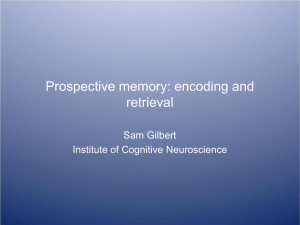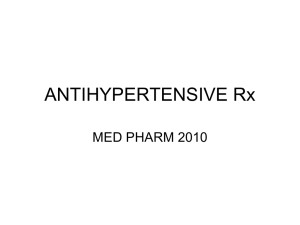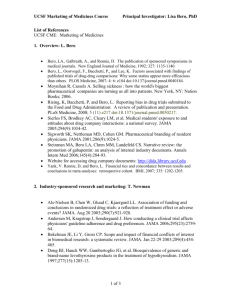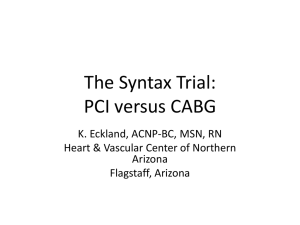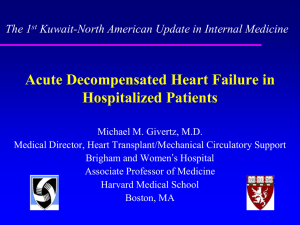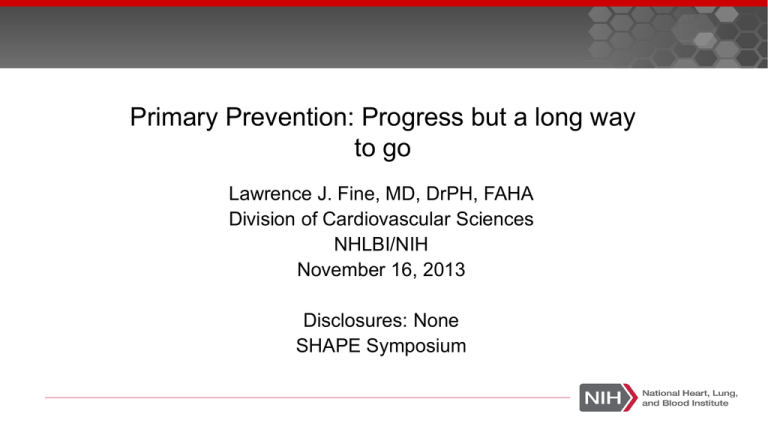
Primary Prevention: Progress but a long way
to go
Lawrence J. Fine, MD, DrPH, FAHA
Division of Cardiovascular Sciences
NHLBI/NIH
November 16, 2013
Disclosures: None
SHAPE Symposium
When I was a glimmer in my parent’s eye the March of
Dimes had a mission to eradicate polio
2
When I was a child …. March of Dimes had to change
3
Declining Annual Change First MI or Death Due CHD
(ARIC study – adjusted for changes in biomarkers) Rosamond Circ 2012
Comparing Whites and Blacks 1987 to 2008
First MI or CHD Death (Blacks)
First MI or CHD Death (Whites)
0
1997-2008
1
2
3
1987-1996
4
5
6
Trends in LDL in Men and Women 1988-2010
Age Specific LDL mg/dL in Adults 60-69. Carroll et al.
2012 JAMA
160
150
140
130
Women
Men
146
139
133
122
120
110
108
100
1988-1994
1999-2002
2007-2010
Better Control of Risk Factors and Treatment of MI
Age Adjusted SBP in Adults 60 + Yrs. 1999 to
2010 NHANES Guo et al. 2012 JACC
145
140
135
10 mm
Delta
No Change
1988 to 1999
130
125
2000
2002
2004
2006
2008
2010
Avoidable Deaths from Heart Dsease, Stroke, and
Hypertensive Disease – United States, 2001 -2010 MMWR
September 6, 2013
Deaths due to lack of preventive health care or timely and
effective medical care can be considered avoidable
Look at CVD mortality for those < 75 years old
Nearly one fourth of all CVD death avoidable
56% of the avoidable deaths in those < 65 ( important target
for primary prevention )
Number of Avoidable Deaths from CVD deaths – United
States, 2001 -2010 MMWR 9/6/2013 Schieb L et al.
Age Groups
2001
2010 (% Decline
over 10 years p < .05)
35-54
46,426
43,884
(- 6%)
55-64
61,105
65,680
(- 27%)
65-74
117,662
87,741
(-37%)
Rates of Avoidable Deaths Data Illustrates Murray’s Eight
Americas: new perspectives on U.S. health disparities.
Race/Ethnicity
and sex
2001 Rates 2010 (% Decline over
per 100,000 10 years p < .05)
Asian Females
36
22 (39%)
White Men
112
81 (28%)
Hispanic Men
93
63 (28%)
Black Men
200
143 (28%)
Asian men 47
MMWR 9/6/2013 Schieb
LJ
Eight Americas: new perspectives on U.S. health disparities.
Murray CJ, et al. 2005 AJP
The Eight Americas Study divides the U.S. population into eight distinct
groups with different mortality experience. Life expectancy for males is
8 is 21 years lower than life expectancy for females. To tackle
disparities in the United States, public health will need to
increase its focus on chronic diseases in young and middleaged Americans. In particular, if blood pressure and
cholesterol are confirmed as major contributors to current
mortality patterns, innovative strategies …unique individual
and population approaches need to be explored.
Influences on Health
Communities
Organizations
Family
Individuals
Genes, Cells, Organs
Adapted from:
The future of the public’s health in the 21st century.
Institute Of Medicine, 2002, and other sources.
Physical and
Socio-political
Environment
“Getting warm …. warmer.”
Challenges of Many Research Opportunities and Few Dollars
Gaps in our knowledge are increasing being recognized
coupled with calls for higher quality studies for decision
making
In addition, RCT’s which involve primary prevention of CVD
are increasing challenging because of falling event rates
Recommended SBP Goals in 2013 ESH/ESC
HTN Guidelines < 80 yrs
SBP Goal
Class
Level
In elderly patients less than 80 old with SBP ≥ 160, there I
is solid evidence to recommend reducing SBP to between
150 to 140 Hg mm.
A
In fit elderly patients less than 80 old < 140 mm Hg may
be considered, whereas in the fragile elderly population
SBP goals should be adapted to individual tolerability
C
IIb
Research Needs 2013 ACC/AHA Cholesterol Guideline
1. Outcomes of RCT’s to evaluate statins for primary
prevention in adults over 75
2. RCTs to evaluate alternate treatment strategies for
CVD risk reduction such as titration to specific
goals vs. fixed dose in high risk patients.
What the possible solutions to this dilemma ?
? More funds
Disruptive technologies
Big data and better studies of observational data sets
More efficient trials where possible.
International Symbol for Don’t Rock the
Boat
18
Original Article
Comparative Effectiveness of Revascularization Strategies
William S. Weintraub, M.D., Maria V. Grau-Sepulveda, M.D., M.P.H., Jocelyn M. Weiss, Ph.D., M.P.H.,
Sean M. O'Brien, Ph.D., Eric D. Peterson, M.D., M.P.H., Paul Kolm, Ph.D., Zugui Zhang, Ph.D., Lloyd
W. Klein, M.D., Richard E. Shaw, Ph.D., Charles McKay, M.D., Laura L. Ritzenthaler, M.B.A., Jeffrey J.
Popma, M.D., John C. Messenger, M.D., David M. Shahian, M.D., Frederick L. Grover, M.D., John E.
Mayer, M.D., Cynthia M. Shewan, Ph.D., Kirk N. Garratt, M.D., Issam D. Moussa, M.D., George D.
Dangas, M.D., and Fred H. Edwards, M.D.
N Engl J Med
Volume 366(16):1467-1476
April 19, 2012
Study Overview
• A large PCI registry and a large CABG registry
were linked to claims records, with data adjusted
for propensity score, to compare clinical
outcomes.
• Patients selected for CABG had a long-term
survival advantage over those selected for PCI.
Propensity Scores for Coronary Artery Bypass Grafting (CABG) in the Percutaneous Coronary Intervention (PCI) and
CABG Populations.
Weintraub WS et al. N Engl J Med 2012;366:1467-1476
Rates of Survival in the CABG and PCI Populations, from
an Analysis Adjusted with the Use of Inverse Probability
Weighting.
RR for
CABG vs.
PCI at
2yrs = .79
( 0.76-.82)
Weintraub WS et al. N Engl J Med 2012;366:1467-1476
Another Disruptive Technology
The Randomized Registry Trial —(Lauer and D’Agostino
NEJM 2013)
With the Thrombus Aspiration in ST-Elevation
Myocardial Infarction in Scandinavia (TASTE) trial...
The investigators designed a large-scale trial to
answer an important clinical question and carried it
out at remarkably low cost by building on the
platform of an already-existing high-quality
observational registry
Lauer et al
With this clever design, which leveraged clinical
information that was already being gathered for the
registry and for other preexisting databases, the
investigators were.., to enroll thousands of patients
in little time, .., to obtain accurate follow-up with
minimal effort, and to report their findings, all for
less than the amount of a typical modular R01
grant
Original Article
Thrombus Aspiration during ST-Segment Elevation
Myocardial Infarction
Ole Fröbert, M.D., Ph.D., Bo Lagerqvist, M.D., Ph.D., Göran K. Olivecrona, M.D., Ph.D., Elmir
Omerovic, M.D., Ph.D., Thorarinn Gudnason, M.D., Ph.D., Michael Maeng, M.D., Ph.D., Mikael Aasa,
M.D., Ph.D., Oskar Angerås, M.D., Fredrik Calais, M.D., Mikael Danielewicz, M.D., David Erlinge,
M.D., Ph.D., Lars Hellsten, M.D., Ulf Jensen, M.D., Ph.D., Agneta C. Johansson, M.D., Amra Kåregren,
M.D., Johan Nilsson, M.D., Ph.D., Lotta Robertson, M.D., Lennart Sandhall, M.D., Iwar Sjögren, M.D.,
Ollie Östlund, Ph.D., Jan Harnek, M.D., Ph.D., and Stefan K. James, M.D., Ph.D.
N Engl J Med
Volume 369(17):1587-1597
October 24, 2013
Study Overview
• The infrastructure of an established PCI registry
was used to conduct a randomized trial
comparing manual thrombus aspiration before
PCI with PCI alone in patients with STEMI.
• There was no significant difference between the
two groups in mortality at 30 days.
Kaplan–Meier Curves for Death from Any Cause and Hospitalization Due to Reinfarction.
Fröbert O et al. N Engl J Med 2013;369:1587-1597
End Points According to Randomization Status and
Treatment Group.
Death rate in trial is 3% vs. 10.5% in those not
randomized – even in this setting.
Fröbert O et al. N Engl J Med 2013;369:1587-1597
Current Funding Notices: RFA-HL-14-019 (UH2/UH3) &
RFA-14-020 (R01):
Low-Cost, Pragmatic, Patient-Centered Randomized
Controlled Intervention Trials
Pragmatic RCTs seek to determine the effectiveness of an
intervention in a real world setting. Trials must leverage
existing clinical practice settings and/or existing electronic
resources such as registries for the conduct of clinical
trials. Trials must include features such as randomization
at the point of patient care; data collection integrated into or
obtained from routine clinical records or similar existing
electronic resources; minimal eligibility criteria, and
interventions delivered as part of routine clinical care.
Thank You (Incomplete List)
Mike Lauer
Joni Snyder
Paul Sorlie
Authors of articles that I used.
30
Enrollment, Randomization, and Follow-up.
Fröbert O et al. N Engl J Med 2013;369:1587-1597
Hazard Ratios for the Primary End Point in Subgroups of Patients.
Fröbert O et al. N Engl J Med 2013;369:1587-1597
Baseline Characteristics of the Patients According to Randomization Status and Treatment Group.
Fröbert O et al. N Engl J Med 2013;369:1587-1597
Conclusions
• Routine thrombus aspiration before PCI as compared with PCI alone did not reduce 30day mortality among patients with STEMI.
Kaplan–Meier Estimates of the Incidence of Outcome Events in the Total Study Population.
Estruch R et al. N Engl J Med 2013;368:1279-1290
Is SPRINT the last of its kind?
FDA’s Mini-Sentinel Disruptive Technology
Curtis L et al. Pharmacoepi Drug Safety. 2012; 21(S1): 21-31
Seminal, High-Impact Findings
“Whether or not the correction of these abnormalities once they
are discovered will favorably alter the risk of development of
disease, while reasonable to contemplate and perhaps attempt,
remains to be demonstrated…”
39
Annals Internal Med 1961;55:33-50
Two perspectives
When It Comes to Trials, Do We Get What We Pay For?
P.J. Devereaux, M.D., Ph.D., and Salim Yusuf, M.B., B.S., D.Phil.
The larger (and more expensive) trials evaluating clinical end points
provide much more definitive and clinically meaningful assessments of
the effect of interventions.
Although these findings suggest value for money when it comes to
large, more expensive trials that are focused on clinical end points,
there is a need to conduct large, definitive trials more efficiently at
reduced costs. Simplifying large trials and eliminating the enormous
bureaucracy and wasteful regulations that exist would make trials more
affordable and would facilitate more rapid evaluation of many additional
hypotheses in large and more definitive trials
Increasing External Validity
“ Although
the best way to control for treatment-selection bias is to
conduct a randomized trial, such trials often have limited power to
evaluate subgroups and the results may not be generalizable, since
patients and centers are often highly selected. Nonrandomized,
observational data from clinical databases can complement
data from clinical trials, because observational data, if they are
from a larger and more representative population, may better
reflect real-world practice.”
NEJM 2012
Unmeasured confounder could it explain the difference?
• As an example of a potential unmeasured confounder,
suppose that patient frailty (yes or no) could be assessed in
our study. If frailty was was present in 10% of the patients in
the CABG group (green curved line) but in 35% of patients
in the PCI group (x axis), and if frailty increased the risk of
death by a factor of slightly more than two (hazard ratio,
2.09), then frailty alone could itself account for the observed
difference in mortality between the study groups.. NEJM 2012
Effect of Unmeasured Confounding Factors.
Weintraub WS et al. N Engl J Med 2012;366:1467-1476
Another Disruptive Technology
The Randomized Registry Trial — The Next Disruptive Technology
in Clinical Research? (Lauer and D’Agostino NEJM 2013)
What good are trials if, they can be used to answer only a tiny fraction
of our important clinical questions?
Enter the registry-based randomized trial. With the Thrombus
Aspiration in ST-Elevation Myocardial Infarction in Scandinavia
(TASTE) trial,.., a new paradigm has emerged that can potentially
release us from the circular (and expensive) trap of the randomizedversus-registry debate. The TASTE investigators designed a largescale trial to answer an important clinical question and carried it out at
remarkably low cost by building on the platform of an already-existing
high-quality observational registry
Lauer et al
With this clever design, which leveraged clinical information
that was already being gathered for the registry and for other
preexisting databases, the investigators were able to quickly
identify potential participants, to enroll thousands of patients
in little time, .. avoid filling out long case-report forms, to
obtain accurate follow-up with minimal effort, and to report
their findings, all for less than the amount of a typical modular
R01 grant
46







